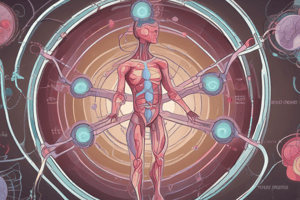Podcast
Questions and Answers
Which of the following is NOT a source of calcium?
Which of the following is NOT a source of calcium?
- Vegetables: Lentils, cabbage
- Fruits: Apples, Oranges (correct)
- Dairy products: Milk, Cheese, egg-yolk
- Nuts
What is the main binding protein for bound calcium in the serum?
What is the main binding protein for bound calcium in the serum?
- Calmodulin
- Phosphate
- Globulin
- Albumin (correct)
Which form of calcium is physiologically active and involved in cellular effects?
Which form of calcium is physiologically active and involved in cellular effects?
- Ionized Calcium (correct)
- Complexed Calcium
- Total Calcium
- Bound Calcium
Which of the following is a biological function of calcium?
Which of the following is a biological function of calcium?
What is the role of ionized calcium in relation to parathyroid hormone (PTH)?
What is the role of ionized calcium in relation to parathyroid hormone (PTH)?
Which of the following is NOT a complexed form of calcium?
Which of the following is NOT a complexed form of calcium?
What is the role of calcium in neuromuscular impulse transmission?
What is the role of calcium in neuromuscular impulse transmission?
Which of the following is the primary calcium-binding protein within the cell?
Which of the following is the primary calcium-binding protein within the cell?
What effect does Parathyroid hormone (PTH) have on plasma calcium levels?
What effect does Parathyroid hormone (PTH) have on plasma calcium levels?
Which form of vitamin D is considered active in calcium metabolism?
Which form of vitamin D is considered active in calcium metabolism?
What is the primary function of calcitonin in calcium regulation?
What is the primary function of calcitonin in calcium regulation?
How does vitamin D influence calcium turnover in the body?
How does vitamin D influence calcium turnover in the body?
What happens to plasma calcium levels when serum calcium exceeds 11.0 mg/dl?
What happens to plasma calcium levels when serum calcium exceeds 11.0 mg/dl?
What is the primary location of calcium in the body?
What is the primary location of calcium in the body?
Which mechanism does NOT contribute to calcium absorption?
Which mechanism does NOT contribute to calcium absorption?
How does acidic pH affect calcium absorption?
How does acidic pH affect calcium absorption?
What is the typical serum calcium concentration in the body?
What is the typical serum calcium concentration in the body?
Which dietary composition is linked to higher calcium absorption?
Which dietary composition is linked to higher calcium absorption?
What percentage of total body calcium is available in the rapid exchange pool?
What percentage of total body calcium is available in the rapid exchange pool?
Which of the following factors decreases calcium absorption?
Which of the following factors decreases calcium absorption?
The majority of intracellular calcium is involved in which of the following processes?
The majority of intracellular calcium is involved in which of the following processes?
Flashcards
Calcium Absorption
Calcium Absorption
The process by which calcium moves from the gut into the bloodstream.
Bone Calcium
Bone Calcium
Calcium is primarily found in the bones, making up almost 99% of the body's total calcium.
Extracellular Calcium
Extracellular Calcium
The tiny portion of calcium located in the blood and other fluids outside of cells, which is about 10,000 times higher than inside cells.
Simple Diffusion (Calcium)
Simple Diffusion (Calcium)
Signup and view all the flashcards
Active Transport (Calcium)
Active Transport (Calcium)
Signup and view all the flashcards
Ca++ Pump
Ca++ Pump
Signup and view all the flashcards
pH & Calcium Absorption
pH & Calcium Absorption
Signup and view all the flashcards
Protein & Calcium Absorption
Protein & Calcium Absorption
Signup and view all the flashcards
What is Calcium?
What is Calcium?
Signup and view all the flashcards
What are some crucial functions of Calcium?
What are some crucial functions of Calcium?
Signup and view all the flashcards
How does Calcium relate to bones and teeth?
How does Calcium relate to bones and teeth?
Signup and view all the flashcards
What are the different forms of Calcium in the blood?
What are the different forms of Calcium in the blood?
Signup and view all the flashcards
Where is Calcium absorbed and what factors affect it?
Where is Calcium absorbed and what factors affect it?
Signup and view all the flashcards
What is Phosphate and what is its role?
What is Phosphate and what is its role?
Signup and view all the flashcards
What is Magnesium and what does it do?
What is Magnesium and what does it do?
Signup and view all the flashcards
What is Mineral Homeostasis?
What is Mineral Homeostasis?
Signup and view all the flashcards
What is the function of Parathyroid Hormone (PTH)?
What is the function of Parathyroid Hormone (PTH)?
Signup and view all the flashcards
How does Vitamin D affect calcium levels?
How does Vitamin D affect calcium levels?
Signup and view all the flashcards
What is the function of Calcitonin?
What is the function of Calcitonin?
Signup and view all the flashcards
What are some key functions of Calcium?
What are some key functions of Calcium?
Signup and view all the flashcards
What is Calcium Homeostasis?
What is Calcium Homeostasis?
Signup and view all the flashcards
Study Notes
Calcium, Phosphate, and Magnesium
- These are essential minerals found in various tissues and body fluids, including bones and teeth.
- Understanding their distribution, homeostasis, and pathophysiology is crucial.
Learning Objectives
- Understand the distribution of Calcium, Phosphate, and Magnesium in the human body.
- Understand Calcium, Phosphate and Magnesium homeostasis.
- Learn the pathophysiology of homeostatic disorders in these elements.
- Identify different roles of the laboratory case studies.
Calcium
- An essential mineral element found in multiple tissues and fluids, notably bones, teeth, and body fluids.
Sources of Calcium
- Nuts
- Vegetables (e.g., lentils, cabbage)
- Dairy products (e.g., milk, cheese, egg yolk)
- Fish (e.g., salmon, sardines)
Biological Functions of Calcium
- Muscle contraction (including heartbeat)
- Metabolic and endocrine functions
- Component of bones and teeth (calcification)
- Blood coagulation
- Transmission of neuromuscular impulses
- Second messenger (e.g., glucagon)
- Enzyme activation (e.g., ATPase)
- Maintains cell membrane integrity
Forms of Plasma Calcium
- Ionized Calcium: Physiologically active fraction, affects cellular effects and PTH control.
- Bound Calcium: Physiologically inactive, mainly bound to albumin (50%) and complexed with ions.
- Complexed Calcium: Salts (e.g., bicarbonate, citrate, phosphate, lactate).
- Total Calcium = Ionized + Bound + Complexed.
- Normal range in mg/dL: 8.4-10.1.
- Normal range in mmol/L: 2.2-2.5
Distribution and Absorption of Calcium in the Body
- Three major body calcium pools:
- Intracellular Calcium: Located in mitochondria and endoplasmic reticulum, levels vary from 100 nmol/L to > 1.00 µmol/L and affects cellular signaling, enzyme activation, and muscle contractions.
- Bone Calcium: Almost 99% of total body calcium, 99% is mineralized, and a small 1% pool exchanges with extracellular calcium.
- Remainder circulates mainly in blood and other extracellular fluids (ECF), approximately 10,000x higher basal concentration in cells compared to plasma, with serum calcium at ~2.20 mmol/L.
- Calcium Absorption Mechanisms: Simple diffusion and active transport (Ca++ pump).
Factors Influencing Calcium Absorption
- pH: Acidic pH increases calcium absorption, while alkaline pH reduces it.
- Dietary composition: Higher protein diet increases calcium absorption by 15%, while a low protein diet results in about 5% calcium absorption.
- Fatty acids: Reduce calcium absorption.
- Minerals (e.g., phosphates, magnesium): Decrease calcium absorption.
- Other factors: Age, health status, hormonal factors.
Calcium Regulation
- GI uptake
- Renal clearance
- Bone
- Endocrine system (PTH, Vitamin D metabolites, Calcitonin)
Calcium Homeostasis - PTH and Vitamin D action
- Mechanisms explain how PTH and Vitamin D maintain calcium levels in the body.
Calcium Homeostasis - Calcitonin action
- Calcitonin's role in regulating calcium levels through feedback mechanisms.
Clinical Importance of Calcium
- Hypercalcemia: Serum Calcium level >11.0mg/dL, Normal Range: 9.0 - 11.0 mg/dL.
- Hypocalcemia: Serum Calcium level <8.5 mg/dl, Normal Range: 9.0 - 11.0 mg/dl.
- Normal Levels: 2.20 to 2.60 mmol/L
Pathophysiology of Calcium Metabolism
- Disorders of homeostatic regulators (PTH, Vitamin D, Calcitonin).
- Disorders of effector organs (Gut, Kidney).
- Disorders of the skeleton.
Hypocalcaemia: Potential Causes
- Hypoproteinaemia
- Decreased intake (vitamin D deficiency, dietary malabsorption)
- Renal disease
- Decreased flux from bone (PTH deficiency, congenital/idiopathic, parathyroid ablation)
- Magnesium deficiency
- Bone resistance to PTH
- Ureamia
- Magnesium deficiency
- Pseudohypoparathyroidism
- Drug-induced (e.g., Mithramycin)
Potential Causes (continued)
- Increased bone uptake (post-parathyroidectomy, post-thyroidectomy, hyperthyroidism).
- Extra-skeletal chelation (e.g., acute pancreatitis, Hyperphosphataemia, renal failure).
- Drug therapy (e.g., frusemide, EDTA, calcitonin, mithramycin, anticonvulsants, phenytoin, barbiturates).
- Sample integrity issues (contamination, IV fluids, anticoagulants).
Symptoms of Hypocalcemia
- Convulsion
- Arrhythmia
- Tetany
- Spasm
- Stridor (breathing difficulty)
Hypercalcaemia: Potential Causes
- Hyperparathyroidism (primary, tertiary, multiple endocrine neoplasia)
- Malignancy (solid tumours, haematological malignancies)
Potential Causes (continued)
- Renal failure (post-dialysis, acute renal failure)
- Increased renal absorption (thiazide diuretics, familial hypocalciuric hypercalcemia)
- Miscellaneous (Addison's disease, Myxoedema, Acromegaly, vitamin A toxicity, Phaeochromocytoma, idiopathic hypercalcaemia of infancy)
- Non-malignant / Non-parathyroid causes (hyperalbuminaemia, dehydration, artefactual, increased intake / absorption, vitamin D intoxication, sarcoidosis, milk alkali syndrome, Iatrogenic, IV infusion)
- Increased bone resorption (thyrotoxicosis.
Clinical Symptoms Associated with Hypercalcemia
- Neuropsychiatric (lethargy, depression, confusion, coma).
- Cardiovascular (ECG changes – reduced QT interval, prolonged PR interval).
- Gastrointestinal (anorexia, nausea, vomiting, abdominal pain, constipation).
- Renal (polyuria, polydipsia, volume depletion, reduced glomerular filtration).
Laboratory Investigation of Calcium Disorders
- Routine measurement: Total Calcium.
- Adjusted (Corrected) Calcium: Values adjusted for albumin changes.
- Investigation of Hypocalcaemia: Sorting out common causes
- Investigation of Hypercalcaemia: Sorting out common causes)
- Pre-analytical factors: In vivo and in vitro factors affecting serum total or free calcium measurements (tourniquet use and venous occlusion, changes in posture, exercise, hyperventilation, fist clenching, alimentary status, alterations in protein binding.
Magnesium
- Essential mineral, involved in various bodily functions.
- Sources include green vegetables, animal sources, dairy products, cereals, potatoes, and beans.
- Distribution: Bone (67%), intracellular (31%), extracellular (~2%).-
- Normal Serum Level: 1.5 - 1.8 mEq/L (0.85 – 1.10 mmol/L).
- Physiologic roles: Enzyme activation, neuromuscular irritability, bone formation, effects on muscle contraction.
- Magnesium metabolism.
- Clinical Significance: Hypomagnesaemia (<7mmol/L), mild, moderate and severe cases. Hypermagnesaemia.
- Symptoms of Hypomagnesaemia: Lethargy, muscle weakness, drowsiness, tetany, tremor, twitching, agitation, vertigo, confusion, cardiac arrhythmias, seizures, nausea, vomiting.
- Causes of magnesium depletion: Renal losses (Diabetes Mellitus, Alcoholism, Hypercalcemia, Hyperaldosterone, Renal Tubular disorders). Gastrointestinal Tract related problems (Diarrhea, vomiting, malabsorption, laxatives and proton-pump inhibitors).
Laboratory Investigation of Magnesium
- Conditions that necessitate Mg investigations: Pre-eclampsia in pregnancy, cardiac arrhythmia, persistent hypokalaemia, tetany after calcium therapy.
- Sample collection.
- Possible samples: Including serum Mg, Red Blood Cell Mg, and Leukocyte Mg, and muscle Mg measurements.
Phosphate
- Inorganic, measured in blood.
- Physiochemical forms include monovalent (H2PO4-) and divalent (HPO42-), with the ratio determined by pH.
- Normal levels vary by age.
- Distribution: Major intracellular ion, with 85% found in bones and teeth, around 15% in soft tissue, and approximately 10% extracellular.
- Physiological roles: High-energy reactions (ATP), calcium balance, intermediary metabolism (proteins, fats, carbohydrates), gene transcription, and cell growth, buffer for body fluids, phospholipids, nucleotides, and other nucleic acids.
- Phosphate Regulation.
- Phosphate Homeostasis.
- Clinical Significance: Hypophosphatemia and hyperphosphatemia.
- Common causes of hypophosphatemia: Intracellular shift, decreased net intestinal phosphate absorption, decreased absorption, intracellular phosphate loss, lowered renal phosphate threshold.
- Common causes of hyperphosphatemia: Decreased renal phosphate excretion, Increased extracellular phosphate load, increased phosphate intake.
- Differential diagnosis for phosphate imbalances and related issues.
Studying That Suits You
Use AI to generate personalized quizzes and flashcards to suit your learning preferences.




